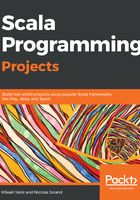
上QQ阅读APP看书,第一时间看更新
Abstract class
An abstract class is a class that can have many abstract members. An abstract member defines only a signature for an attribute or a method, without providing any implementation. You cannot instantiate an abstract class: you must create a subclass that implements all the abstract members.
Replace the definition of Shape and Rectangle in the worksheet as follows:
abstract class Shape(val x: Int, val y: Int) {
val area: Double
def description: String
}
class Rectangle(x: Int, y: Int, val width: Int, val height: Int)
extends Shape(x, y) {
val area: Double = width * height
def description: String =
"Rectangle " + width + " * " + height
}
Our class Shape is now abstract. We cannot instantiate a Shape class directly anymore: we have to create an instance of Rectangle or any of the other subclasses of Shape. Shape defines two concrete members, x and y, and two abstract members, area and description. The subclass, Rectangle, implements the two abstract members.
You can use the prefix override when implementing an abstract member, but it is not necessary. I recommend not adding it to keep the code less cluttered. Also, if you subsequently implement the abstract method in the superclass, the compiler will help you find all subclasses that had an implementation. It will not do this if they use override.